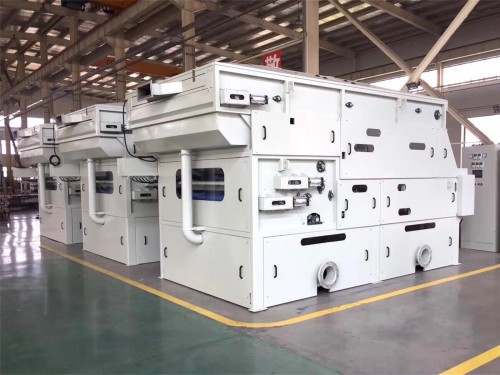Automatic Dehydrator Waste Sludge Dewatering Machine For Sewage Treatment
Our company are always focusing on independent technology innovation of themselves. Under the cooperation with Tongji University, we have successfully developed the new generation of sludge dewatering technology - multi-plate screw press, a screw type sludge dehydrator that is much more advanced in very aspects than belt presses, centrifues, plate-and-frame filter presses, etc. It features clogging-free, wide range of applications, low energy consumption, simple operation & maintenance.
Main Parts:
Sludge concentration & dewatering Body; Flocculation & Conditioning Tank; Integrate Automatic Control Cabinet; Filtrate Collection Tank
Working Principle:
Force-water concurrent; Thin-layer dewatering; Moderate press; Extension of the dewatering path
It has solved several technical problems of other similar sludge dewatering equipment including belt presses, centrifuge machines, plate-and-frame filter press have, which are frequent clogging, low concentration sludge / oil sludge treatment failure, high energy consumption and complicated operation etc.
Thickening: When the shaft is driven by the screw, moving rings around the shaft move up and down relatively. Most water is pressed out from the thickening zone and fall down to the filtrate tank for gravity.
Dewatering: The thickened sludge moves forward continuously from the thickening zone towards the dewatering zone. With the pitch of the screw shaft thread getting narrower and narrower, the pressure in the filter chamber increases higher and higher. In addition to the pressure generated by the back-pressure plate, the sludge is greatly pressed and dryer sludge cakes produce.
Self-cleaning: The moving rings rotates continuously up and down under the pushing of the running screw shaft while the gaps between the fixed rings and moving rings are cleaned to prevent from clogging that happens frequently for traditional dewatering equipment.
Product Feature:
Special pre-concentrating device, wide feed solids concentration: 2000mg/L-50000mg/L
The dewatering part consists of a thickening zone and a dewatering zone. In addition, a special pre-concentrating device is mounted inner the flocculation tank. The applicable feed solids concentration can be as very wide as 2000mg/L-50000mg/L.
Model Selection
|
Model
|
WAS Sludge
& Chemical Precipitated Sludge
(Thin Sludge)
|
Dissolved Air Flotation Sludge
|
Mixed Raw Sludge
Aerobic Digested Sludge
& Sewage Sludge
|
||
|
Sludge Concentration (TS)
|
0.2%
|
1%
|
2%
|
5%
|
3%
|
|
HBD 051
|
~0.4 kg-DS/hr
(0.2 m³/hr) |
~0.6 kg-DS/hr
(0.06 m³/hr)
|
~2 kg-DS/hr
(0.1 m³/hr)
|
~4 kg-DS/hr
(0.08 m³/hr) |
~5 kg-DS/hr
(0.16 m³/hr) |
|
HBD 101
|
~2 kg-DS/hr
(1.0 m³/hr) |
~3 kg-DS/hr
(0.3 m³/hr) |
~5 kg-DS/hr
(0.25 m³/hr) |
~10 kg-DS/hr
(0.2 m³/hr) |
~13 kg-DS/hr
(0.43 m³/hr) |
|
HBD 131
|
~4 kg-DS/hr
(2.0 m³/hr) |
~6 kg-DS/hr
(0.6 m³/hr) |
~10 kg-DS/hr
(0.5 m³/hr) |
~20 kg-DS/hr
(0.4 m³/hr) |
~26 kg-DS/hr
(0.87 m³/hr) |
|
HBD 132
|
~8 kg-DS/hr
(4.0 m³/hr) |
~12 kg-DS/hr
(1.2 m³/hr) |
~20 kg-DS/hr
(1.0 m³/hr) |
~40 kg-DS/hr
(0.8 m³/hr) |
~52 kg-DS/hr
(1.73 m³/hr) |
|
HBD 202
|
~16 kg-DS/hr
(8.0 m³/hr) |
~24 kg-DS/hr
(2.4 m³/hr) |
~40 kg-DS/hr
(2.0 m³/hr) |
~80 kg-DS/hr
(1.6 m³/hr) |
~104 kg-DS/hr
(3.47 m³/hr) |
|
HBD 301
|
~20 kg-DS/hr
(10 m³/hr) |
~30 kg-DS/hr
(3.0 m³/hr) |
~50 kg-DS/hr
(2.5 m³/hr) |
~100 kg-DS/hr
(2.0 m³/hr) |
~130 kg-DS/hr
(4.33 m³/hr) |
|
HBD 302
|
~40 kg-DS/hr
(20 m³/hr) |
~60 kg-DS/hr
(6.0 m³/hr) |
~100 kg-DS/hr
(5.0 m³/hr) |
~200 kg-DS/hr
(4.0 m³/hr) |
~260 kg-DS/hr
(8.67 m³/hr) |
|
HBD 303
|
~60 kg-DS/hr
(30 m³/hr) |
~90 kg-DS/hr
(9.0 m³/hr) |
~150 kg-DS/hr
(7.5 m³/hr) |
~300 kg-DS/hr
(6.0 m³/hr) |
~390 kg-DS/hr
(13 m³/hr) |
|
HBD 402
|
~80 kg-DS/hr
(40 m³/hr) |
~120 kg-DS/hr
(12 m³/hr) |
~200 kg-DS/hr
(10 m³/hr) |
~400 kg-DS/hr
(8.0 m³/hr) |
~520 kg-DS/hr
(17.3 m³/hr) |
|
HBD 403
|
~120 kg-DS/hr
(60 m³/hr) |
~180 kg-DS/hr
(18 m³/hr) |
~300 kg-DS/hr
(15 m³/hr) |
~600 kg-DS/hr
(12 m³/hr) |
~780 kg-DS/hr
(26 m³/hr)
|







